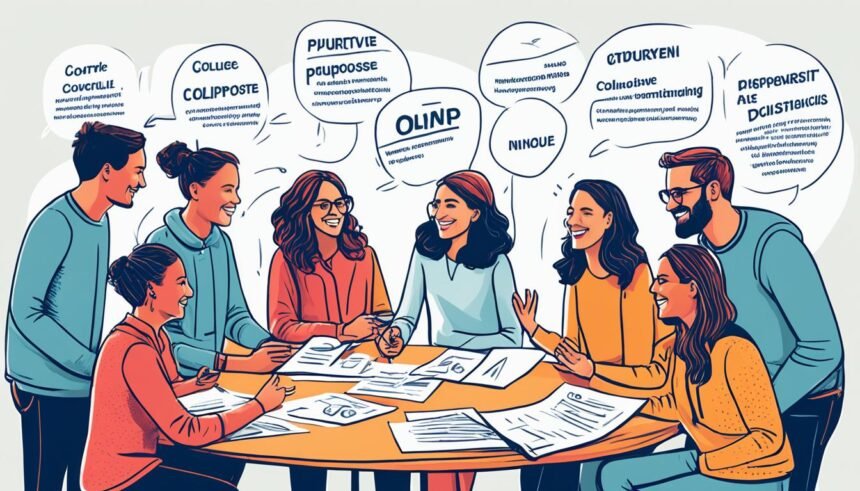At the core of any well-run organization is a leadership style built on democratic principles. It values everyone’s ideas, aiming to make decisions together. This method thrives on open talks, shared decisions, and a sense that everyone is in it together.
Instead of a top-down approach, democratic leaders draw on their team for ideas and consensus. This includes everyone and often leads to choices that everyone supports. It’s widely seen as a good way to run things because it makes every team member feel responsible, boosting morale and creativity. This way, organizations use everyone’s strengths for the greatest good, boosting cooperation and the feeling of being part of something important.
Key Takeaways
- Democratic leadership values working together, talking openly, and including everyone in decisions.
- Leaders listen to their teams, they weigh different viewpoints, and they bring in others when making choices.
- This style makes everyone feel like they own what they’re doing, making the team work as a whole.
- It’s a central method for growing new ideas and making organizations do better.
- Putting power in the hands of the many and being open about activities are key in this type of leadership.
The Essence of Democratic Leadership
Democratic leadership is all about making sure everyone’s voice counts. Leaders involve people at every level to get their ideas. This approach taps into the team’s full potential, leading to new ideas and a strong team bond.
Prioritizing Collaboration and Shared Decision-Making
Collaboration and teamwork are key under democratic leadership. Leaders work to nurture open discussions and cooperative work to reach goals. By bringing together different talents and viewpoints, they aim for a shared vision.
Fostering Inclusivity and Diverse Perspectives
Under this leadership, diverse perspectives power the team forward. Everyone is encouraged to add their unique insights to the mix. This creates a rich pool of ideas that can lead to innovative solutions.
Fostering Collaboration
Democratic leadership puts a spotlight on working together as a team. This style sees collaboration and teamwork as keys to success. These leaders support their team’s open communication, brainstorming, and making decisions together. This way, they deal with obstacles and reach their goals as one.
These leaders use the variety of skills and views their team offers. This creates a culture where everyone aims for a shared goal. Team members feel more responsible and involved because they can share their ideas and help in choices.
| Collaborative Leadership Practices | Benefits |
|---|---|
|
|
Through these collaborative leadership methods, organizations can unlock their team’s power. This helps face hard tasks, spur innovation, and meet goals more effectively.
Promoting Inclusivity
At the center of democratic leadership is inclusivity. This means valuing and listening to everyone’s voice. Leaders involve all employees in decision-making, seeking their input and involvement. This fosters a participative culture, encouraging innovation and creating a sense of belonging.
Equal Voice for All Team Members
Democratic leaders make sure everyone, no matter their role, can contribute equally. This opens the door for various ideas in the decision-making process, leading to better solutions.
Empowering Individuals and Building Trust
Empowerment is key in democratic leadership. Leaders allow their teams to make decisions and work independently. This strategy helps employees grow professionally, leading to a culture of trust and success for the whole team.
Benefits of Democratic Leadership
Democratic leadership brings people together. They all aim towards a shared goal. This leads to
enhanced problem-solving and creativity
. By using the different skills and views of their team, democratic leaders can find new, creative solutions. These ideas might not come up under a bossy style.
Empowerment and inclusivity are big parts of democratic leadership. Research shows they increase employee engagement and job satisfaction. This helps the whole organization do better.
| Benefit | Description |
|---|---|
| Collaborative Problem-Solving | Democratic leadership creates a space for open talks and working together on decisions. This lets teams use different views and expertise to solve tough problems. |
| Employee Engagement | Giving employees power and making them part of choices makes them more involved. This leads to more engagement from them. |
| Job Satisfaction | Working in a team and helping decide things makes employees happier. They feel they matter and help steer the organization’s future. |
| Organizational Success | Democratic leadership boosts problem-solving, employee engagement, and joy at work. All this helps the whole organization do better. |
Challenges and Considerations
Demanding challenges come with democratic leadership, yet it has many pros. One big issue is that decision-making can get slow and messy, especially in big groups. Not everybody may like sharing their say in decisions, especially if they’re used to just being told what to do.
Potential for Inefficiency in Decision-Making
Choosing things together in a democratic setup sounds great, but it can be a slow process. In big groups, it’s hard to get everyone to agree, which might mean missing chances to act fast when needed.
Resistance to Change and Participative Processes
Changing to a more open and democratic leadership can be tough for some. Team members might not want to be as involved, preferring clear orders from above. They may not see the benefits of everyone having a say.
Leaders also have to walk a fine line, making sure everyone’s empowered but also responsible. It’s a balancing act to make sure people have what they need to do well while making sure they deliver.
| Challenge | Description |
|---|---|
| Decision-Making Efficiency | The participative and collaborative nature of democratic leadership can lead to time-consuming decision-making processes, particularly in large organizations with diverse stakeholders. |
| Resistance to Change | Some team members may be uncomfortable with the level of participation and empowerment required in a democratic setting, preferring more traditional, top-down management styles. |
| Balancing Empowerment and Accountability | Leaders must ensure that individuals have the support and resources they need to succeed while holding them accountable for their actions and outcomes. |
Democratic Leadership in Action
Democratic leadership is now making big waves in the business world. Leading organizations such as Google, Southwest Airlines, and Zappos are using this approach. They’re seeing great outcomes. Their cultures are changing, and they are more successful.
Google’s Innovative Culture and Empowerment
Google stands out for its creative environment and democratic values. Its founders, Larry Page and Sergey Brin, set the tone. They focused on working together, staying open, and giving power to everyone.
This strategy has helped create an energized and creative staff. It has driven Google’s growth as a major tech player.
Southwest Airlines’ Servant Leadership Approach
Southwest Airlines also uses democratic leadership to build a team-based, empowering atmosphere. They promote values like teamwork, customer focus, and respect at every level. Their leadership puts the team first, aiding Southwest in the airline market.
Zappos’ Self-Managed Teams and Holacracy
Zappos takes a unique road on the democratic leadership journey. CEO Tony Hsieh made a culture that’s about trust, freedom, and being clear. At Zappos, employees run their groups and make many choices themselves. They’ve also embraced Holacracy to encourage self-managed team and authority sharing.

Effective Communication: The Foundation of Democratic Leadership
Communication is key in democratic leadership. It encourages an open dialogue and builds trust for making decisions together. This way, team members feel free to share their ideas and opinions, which makes the work environment more respectful and united.
When leaders promote open talks, they tap into their team’s knowledge and experience. This leads to better problem-solving and decisions. Each team member can add valuable insights, which grows a culture of trust and joint responsibility.
Also, good communication helps solve conflicts. Leaders guide the team to talk openly and find solutions that everyone can agree on. This method not only brings teams closer but also leads to more creative and solid results.
| Characteristics of Effective Communication in Democratic Leadership | Benefits |
|---|---|
|
|
To sum up, effective communication underpins democratic leadership. By fostering open discussion and diverse ideas, leaders can bring out their team’s best. This approach drives success by building trust and supporting collaboration.
Conflict Resolution and Consensus-Building
Democratic leaders focus on working together and teamwork for success. They value open talks and sharing ideas. This way, team members can solve issues and meet their goals together. When people work closely, they might not always agree. In a democratic place, this disagreement is seen as a chance to learn and come up with new ideas.
Facilitating Healthy Conflict Resolution
Leaders help teams talk through their issues calmly. This can lead to better solutions and tighter team bonds. They create a space where everyone feels safe to share their thoughts. By listening to different points of view and finding solutions that everyone can agree on, they tackle problems well. This also makes the team stronger and more united.
Building Consensus Through Collaboration
Democratic leaders let team members be a part of making decisions. This helps in reaching agreements through working together to solve problems. They communicate openly and listen to each other. They also know that sometimes you have to give a little to find the best way forward. Everyone feels like they own the goals, which makes them more committed.
| Conflict Resolution Strategies | Consensus-Building Techniques |
|---|---|
| Facilitated Discussions | Collaborative Problem-Solving |
| Negotiation and Compromise | Shared Decision-Making |
| Active Listening and Empathy | Inclusive Brainstorming |
| Win-Win Resolutions | Collective Goal-Setting |
Democratic Leadership: Fostering Collaboration and Empowerment
Democratic leadership is a transparent and open way to manage a group. It focuses on team work, making everyone feel part of things, and giving workers more say in what happens. When groups follow these ideas, they build trust, respect, and new ideas, which leads to better work and long-lasting success. In fast-changing times, democratic leadership is key to making groups strong, bringing people together, and reaching common aims.
This kind of leadership values letting everyone help make decisions. Those who lead democratically let their team members share their thoughts and skills. This works well because it makes everyone feel involved and responsible. Plus, it brings together different viewpoints and sparks creativity in the team.
Democratic leaders also really think open talks are important. They work to make an environment where everyone can speak up and question old ideas without fear. Easy communication helps find new answers and makes the team feel more connected. This way, groups can adapt faster and stay strong in the face of change, using everyone’s talents to grow together.
Conclusion
Democratic leadership is a key way to run organizations. It encourages working together and giving everyone a voice. By focusing on teamwork and letting everyone have a say, leaders build a strong team that comes up with new ideas and feels responsible for their work.
Though it has its difficulties, democratic leadership boosts problem-solving and makes employees more involved. It’s a model many leaders find very effective today. As the world changes quickly, these leadership values help teams work well together and reach their goals.
Companies like Google, Southwest Airlines, and Zappos show how powerful this leadership style can be. They lead by example, showing others how to create a more united and empowered workplace. By following the main ideas of democratic leadership, companies can foster trust and encourage new thinking. This can set them on a path to lasting success and growth.
FAQ
What is democratic leadership?
Democratic leadership values team members’ input to make decisions. It is all about working together. Leaders and team members talk openly and collaborate.
What are the key principles of democratic leadership?
In democratic leadership, every voice is important. Leaders give people power and freedom to make choices. They also encourage working together to reach common goals.
How does democratic leadership foster collaboration?
Leaders promote team discussions and group work to solve issues and meet goals. They use everyone’s different skills and ideas to work towards success together. This builds a culture of working as a team.
How does democratic leadership promote inclusivity?
Leaders involve everyone in making decisions, no matter their role. This makes employees feel they belong and are important. It also encourages new and creative ideas.
What are the benefits of democratic leadership?
Democratic leadership improves how problems are solved and new ideas are developed. Employees feel more involved and happy in their work. It leads to success for the whole organization.
What are some of the challenges of democratic leadership?
Making decisions can take longer and be more complicated in big companies. Some team members might not like being so involved in decision-making.
Can you provide examples of organizations that embrace democratic leadership?
Google, Southwest Airlines, and Zappos follow democratic leadership. They build success by working as a team, being open, and giving power to their employees.
How does effective communication support democratic leadership?
Good communication is key in democratic leadership. It builds trust and helps everyone work together. Leaders listen to their teams and use their ideas.
How do democratic leaders navigate conflict resolution and consensus-building?
Leaders see conflicts as chances to learn and find new solutions. They help their team come to agreements by working together. This makes the team stronger and more united.






